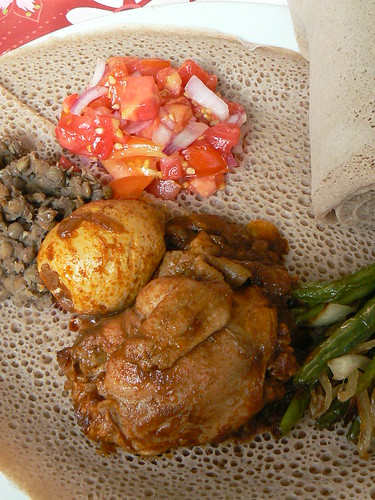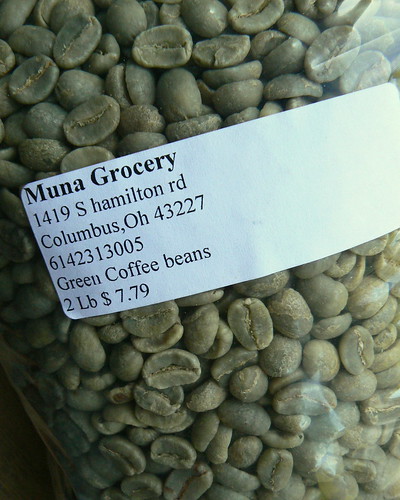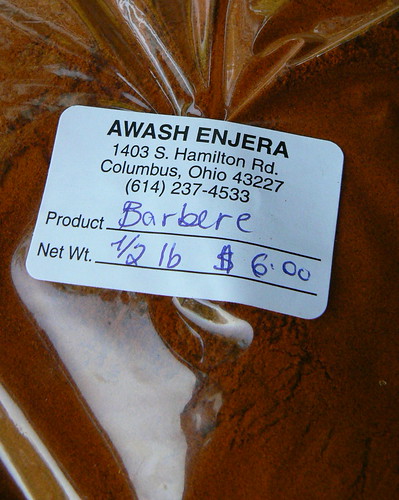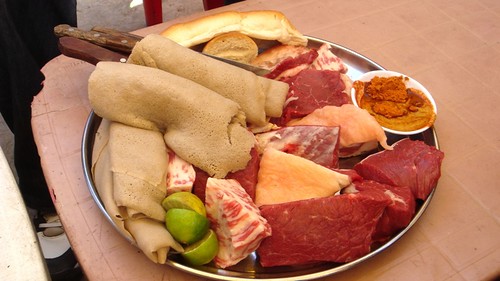
I love Ethiopian food. It's even better when you can make it at home. If you are lucky enough to live in Columbus Ohio, then you have easy access to all the ingredients you need to make a Habesha feast.
My sister, Finny and I went out to a mini mall on Hamilton, our first stop was Awash Enjera. There we picked up some Barbere, some other spices, and of course enjera. Awash has most everything you need, but if you want to comparison shop you can mosey a few doors down to the Muna International Grocery.

I bought some green coffee beans, I'm gonna try roasting my own.
Berbere (I have seen it spelled different ways) is mixture of spices somewhere between chili powder and curry.
My sister, (Jeanlouise: Jolie) did most of the cooking, she made lentils, Chicken stew (doro wat), green beans, and a tomato salad. everything is pretty easy to make, if you want a recipe, send me a note using the "contact us" button.
Fun food that's easy to make, give it a try.
Cheers.
Awash Enjera
1403 S. Hamilton Rd.
Columbus, OH 43227
614-237-4533
Muna Grocery
1419 S. Hamilton Rd.
Columbus, OH 43227
614-231-3005
PS: Now for some pictures of stuff I don't think you should try at home (yet). Jeanlouise just got back from Ethiopia here's a few shots of what she ate there:
Tibs
Tere Sega
All served with Hamot (Click on picture for translation).
Showing posts with label tibs. Show all posts
Showing posts with label tibs. Show all posts
18 August, 2009
Enjera Ohio
07 November, 2007
The Ethiopia Report
 Raw goat served here with mitmita. Eating tere sega is similar to eating sashimi.
Raw goat served here with mitmita. Eating tere sega is similar to eating sashimi.(Jolie cabled from the continent the following report)
From September 2006 to September 2007, I had the opportunity to work on food security related issues while living in Addis Ababa. Unfortunately, Ethiopia usually conjures up visions of starving, fly-in-the-eye children and a general mass of helpless hungry humanity. I came to appreciate that while Ethiopia is a poor, densely populated rather drought prone country, food is actually readily available. I’d spent the greater part of the last ten years living in Washington, DC, so I was not unfamiliar with habesha (ethiopian) cuisine. This assignment did prove to be my master class in ethio-style eating. I learned that habesha food is a relatively simple cuisine, but with powerful spices and flavors that make it sophisticated and some of the most interesting food one can experience. Some of my favorites . . . .
Kitfo.
Finely minced beef (chop by hand, only high quality lean cuts such as tenderloin)
Kibey (spiced garlic, cumin, coriander, basil, clarified butter)
Mitamita (spicy-salty blend of chili peppers, salt, ginger, onion, garlic, cumin, cardamon)
Kitfo.
Finely minced beef (chop by hand, only high quality lean cuts such as tenderloin)
Kibey (spiced garlic, cumin, coriander, basil, clarified butter)
Mitamita (spicy-salty blend of chili peppers, salt, ginger, onion, garlic, cumin, cardamon)
 Kitfo Lebleb with lab (cheese) and gomen (greens).
Kitfo Lebleb with lab (cheese) and gomen (greens).Kitfo is a very special food in Ethiopia. It is traditionally eaten by the Gurage, an ethnic group from the south-western part of the country, but now-a-days it very much a part of the greater culture. It is a dish especially eaten by urban dwellers (men and women alike) who have been more exposed to mixing cultures and have the income to afford them this delicacy. Kitfo is a simple dish of minced beef, butter and spices that is most often served raw or gently warmed. There is something powerful about raw meat-- it evokes feelings and associations that are much more vivid that its cooked counterpart- perhaps a way the human animal expresses its dominance over other species.
Kitfo is served one of three ways: raw (tere), warmed (lebleb) or fully cooked (abasala). Most people will tell you there is not point getting the fully cooked version, it is still quite tasty but it is not the full experience. The kitfo is accompanied by fresh, homemade cheese not unlike fresh ricotta called lab and served along with gomen, similar to collard greens. The kitfo is arranged in a clay bowl atop a banana leaf doily. There is usually a puddle of butter gathering in the banana leaf as you work your way towards the bottom on the bowl. Kitfo is eaten by hand with injera, kocho (a fermented enset bread) or with a very long spoon. Kocho is supposedly an acquired taste that I loved the instant I got it into my jaws. Some have compared kocho to eating carpet padding. I find it has an interesting texture and a cooling effect that is welcome while eating fiery kitfo.
It is a sight to see a group of smartly dressed people gathered around a lunch table, elegantly brandishing long spoons, eating this dish. Many non-ethiopians I met in Addis were hesitant to try Kitfo, expressing concerns over disease, sickness and parasites-- “why would I eat that? I don’t want to die” a friend told me. You want to eat it because it is absolutely delicious. It is better raw than cooked and probably completely safe to eat in most restaurants, especially in the US where there are strict meat handling regulations. Note-- you dont need a lot of this to fill-up. Four of us ordered three portions and were experiencing serious belly-swelling before the third bowl could be finished. The butter makes kitfo a particularly rich food.
 Derek Tibs (fried goat)
Derek Tibs (fried goat)Tibs.
Amharic for ‘fried’, tibs are most ubiquitous chomp in Ethiopia. And they are delicious because what is not to love about pan fried meat? Ethio-tip number one: if you find yourself in a sketchy restaurant, get the tibs, your intestines will thank you. Tibs are made from many different animals, but mostly goat, sheep and cow. Fish tibs refers to an entire whole fried fish, which was confusing for me. . . . . Before frying, the meat is prepared by chopping various cuts in to bite sized chunks (though there are variations such as the finger shaped zilzil tibs). The meat can be mixed with rosemary, onion, jalapeno, tomato, bebere* and then pan fried in butter or oil. The ‘derek’ or dry tibs is a delicious variation where by the meat is simply pan fried to a crisp all on its own, raw shallots are added after frying. Derek tibs are frequently served in a clay dish set over coals. Each order of tibs should be accompanied by a set of riblets. It is proper ethio-etiquitte to eat the riblets after having consumed the rest of the dish. I insist on eating my tibs with plenty of mitmita, otherwise its just the burger without the cheese. Others prefer awaze (berbere paste) or sene fitch (Ethiopian mustard).
*Berbere is the most essential element in ethiopian cooking. It is a blend of chilies, onion, ginger, bishop’s weed, cloves, coriander, etc. Most households prepare their own berbere, thus the exact ingredients will vary according to tastes and family recipes.
 Bozena shiro
Bozena shiro Shiro Wat.
My bread and butter, shiro wat, is the mac & cheese of Ethiopian cuisine. The prepared packets of roasted ground chickpeas and spices need only be combined with oil, water and shallots to provide a satisfying and comforting meal. Nothing feels quite a nice as warm shiro on a chilly day. If you’d like to try shiro at your local Ethiopian restaurant, you will probably see it in either of its two basic forms: Bozena shiro (shiro with chunks of meat) or vegetarian shiro (without the meat). I prefer straight shiro with butter. If you’d like to try shiro at home, it’s quite easy to whip up if you are able to find shiro flour in your locality. Here is a link to a recipe: http://www.ethiopianmillennium.com/SHIRO.html. Shiro is best served piping (boiling!) hot in a clay dish with a lid to keep the sauce warm-- then you gradually spoon out the wat on to the injera waiting to soak it all up. A regular sauce pans works fine too. If you find yourself in Addis, the best shiro I found was at the Crocodile Cafe located near the National Theatre on Churchill Avenue. Though owing to the fact it is a most basic cheap and delicious ethio-staple, it is available at most food outlets.
Shiro flour:
roasted chickpeas
cumin
cardamon
basil
bishops-weed
ginger
garlic
There are many more wonderful and exciting dishes in the habesha kitchen. If you have the opportunity to try tere sega (raw meat), dulet (a mix of minced tripe, liver and beef), doro wat (spicy chicken stew) or the variety of vegan fasting foods, take full advantage, especially if you love spicy, exciting food.

Playing pool with a horse in Addis.
(Thanks Jolie. For more photos check out Jolie's Flickr page)
Cheers.
04 September, 2007
Postcard from Addis
Hi Macmac--
This weekend some buddies and me went out of town for a tibs (fried goat) and tej(honey wine) fest. We also got some tera sega (raw (goat) meat). it was pretty awesome, a real canivore's delight. I had never tried the raw stuff before, and it was really surprisingly delicious. Kinda like sashimi, like you might expect. Since there is a butchery inside the restaurant, you know it's fresh. you order by the kilo, and the waiter goes over to the butcher stand and the dude hacks off the right amount and the waiter brings it back to the table. Pretty awesome. Probably nothing like that in the states due to some heath code what have you.
The tej was pretty fantastic as well, since it is basically the wine-cooler of Ethiopia, it can really sneak up on you so you gotta be careful. Anyways, since I haven't gotten around to learning how to cook here yet, I thought I could write an article about eating here for saucison. How does that sound?
talk to you soonnnnnnm,
jloie
This weekend some buddies and me went out of town for a tibs (fried goat) and tej(honey wine) fest. We also got some tera sega (raw (goat) meat). it was pretty awesome, a real canivore's delight. I had never tried the raw stuff before, and it was really surprisingly delicious. Kinda like sashimi, like you might expect. Since there is a butchery inside the restaurant, you know it's fresh. you order by the kilo, and the waiter goes over to the butcher stand and the dude hacks off the right amount and the waiter brings it back to the table. Pretty awesome. Probably nothing like that in the states due to some heath code what have you.
The tej was pretty fantastic as well, since it is basically the wine-cooler of Ethiopia, it can really sneak up on you so you gotta be careful. Anyways, since I haven't gotten around to learning how to cook here yet, I thought I could write an article about eating here for saucison. How does that sound?
talk to you soonnnnnnm,
jloie
Thanks JL, hope to see you soon. By the way, If anyone wants to party like it's 1999, Ethiopia is having it's Milenium celebration on September 12th. Seven years late you say? No, Ethiopia follows the Julian Calendar. Read more here in an artlicle from the Guardian.
Happy New Year.
Cheers.
Subscribe to:
Posts (Atom)


